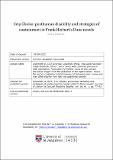Crip Gholas : posthuman disability and strategies of containment in Frank Herbert’s Dune novels
Abstract
Michael Bérubé has recently argued that representations of disability in science fiction are almost ubiquitous but heavily underrecognized. The article builds on Bérubé’s remark to discuss the constructive effects of adding critical disability studies to the approaches that have focused on Frank Herbert’s Dune series. The argument is that a disability-informed reading of the character Duncan Idaho across all six original Dune novels exposes a range of ableist assumptions upon which the narrative relies. Genetically engineered, the reincarnations of Idaho might be read as implying posthuman possibility. In contrast, the article demonstrates the ways in which Herbert’s characterization of Idaho and the latter’s relationship to Dune’s society represent ableist ideologies. By discussing Idaho’s storyline and Dune’s ableist social constructions, the article highlights a series of narrative anxieties and strategies of containment that undermine any possible interpretation of Idaho’s disability as socially acceptable and limit the ways in which Herbert’s portrayal of Idaho may be used to imagine a positive presence of disabled people in future scenarios.
Citation
Simonetti , N 2022 , ' Crip Gholas : posthuman disability and strategies of containment in Frank Herbert’s Dune novels ' , Journal of Literary & Cultural Disability Studies , vol. 16 , no. 1 , pp. 77–92 . https://doi.org/10.3828/jlcds.2022.5
Publication
Journal of Literary & Cultural Disability Studies
Status
Peer reviewed
ISSN
1757-6466Type
Journal article
Collections
Items in the St Andrews Research Repository are protected by copyright, with all rights reserved, unless otherwise indicated.

